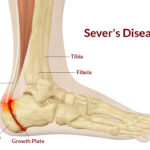
Diabetic Foot
DIABETES MELLITUS – THE DIABETIC FOOT
The number one request for allied health professionals is to perform a diabetic check and to provide assistance for diabetic foot and health management.
WHAT IS DIABETES MELLITUS?
Let’s start at the beginning. Diabetes Mellitus, or diabetes, is a condition that is caused when the pancreas is either unable, or is unable to produce the hormone insulin.
Insulin is required to convert sugar, or glucose, into energy. Therefore, without insulin, any glucose is left to circulate through the blood stream. It can only be removed through the urine.
THERE ARE TWO TYPES OF DIABETES
Type 1 diabetes occurs when the pancreas is unable to produce any insulin at all.
This is typically an inherited condition that will usually show itself before the age of thirty (although it can come about at any age). Type 1 diabetes is typically treated with daily insulin injections to assist the body in converting glucose.
Type 2 diabetes occurs when the pancreas produces some insulin, but not enough to match the demands required. Therefore, the body is unable to convert all blood sugar in the body.
Like type 1, this condition also has a genetic component. However, it can be exacerbated through a number of medical or lifestyle factors as well. These include being overweight, having high blood pressure, leading a sedentary lifestyle, or having a poor diet.
Type 2 diabetes may be managed through changes to lifestyle such as exercising or changing to a healthier diet. It may also be treated through various tablet medications, or sometimes insulin injections.
SO, WHAT DOES ALL OF THIS HAVE TO DO WITH THE FEET?
It’s all related to the heightened blood sugars. There are two main changes that podiatrists monitor: changes to circulation and changes to nerve conduction.
CHANGE IN BLOOD CIRCULATION
As the concentration of blood sugar increases, the blood vessels can begin to form plaques on the blood vessel walls (atherosclerosis). These become partial blockages in blood vessels, which in turn can reduce the flow of blood to the foot.
The foot relies on a healthy flow of blood to assist with healing, to provide nourishment to the various tissue cells, and to transport immune factors to assist in fighting off infection.
If the flow of blood is compromised, healing times from injury increase, the likelihood of developing infection increases. Therefore, the skin texture often changes to become more dry, rough, and susceptible to damage.
CHANGES IN NERVE CONDUCTION
In addition to these vascular changes, high levels of blood glucose are also
absorbed readily into nerve tissue.
Over time, this exposure to blood sugar causes damage to nerve conduction; usually occurring at the periphery (i.e. the toes) first.
Sensory nerves can become affected, and over time changes in sensation can be experienced. Burning, pins and needles, or hypersensitivity may all
be experienced initially.
As the process continues it can develop into complete numbness, where the toes and feet are unable to detect any sensation. This condition is known as peripheral neuropathy.
In addition, the motor nerves (i.e. the nerves responsible for moving things) may also be affected. Tendons and muscles can become rigid and tight and develop into deformities that can change the distribution of pressures throughout the foot. These high-pressure areas can develop into ulcers.
WHAT ARE THE RISKS IF BOTH CHANGES ARE PRESENT?
The largest concern occurs when changes to circulation and nerves are both present. There is an increased risk of injuring the foot without being aware of it (due to the nerve changes). Followed by a decrease in healing and an increase in chance of infection (due to the vascular changes).
A diabetic infection can become very serious, very quickly. If the infection reaches the bone, it can become a condition known as osteomyelitis which is very difficult to treat and may result in the requirement of amputation to prevent any further spread throughout the body.
TIPS ON HOW TO MANAGE DIABETIC FOOT
In saying that, diabetic foot management is not all doom and gloom. Infections and complications can be avoided by taking a few simple precautions. If you are diabetic, it is important to take the following advice:
- Ensure that you eat a well-balanced diet avoiding excess sugars.
- Take your diabetic medications regularly.
- Monitor your blood glucose levels regularly.
- Exercise – this is a great way to help burn off excess sugar in the blood.
- Keep the feet covered at all times. This will assist in preventing any unexpected injury.
- Regularly inspect the feet visually. If you find it difficult to see the bottom of your feet, you can use a portable mirror propped against the bottom corner of a wall to assist you.
- Keep your heels hydrated with a good heel balm. This will assist in preventing the skin from drying and cracking.
- Wear sensible footwear that does not cause excessive rubbing or damage to your feet.
- See a podiatrist regularly to assess nerve and vascular function.
- See an Exercise Physiologist to assist with circulation, strength and conditioning.
By following these simple recommendations, you will be minimising the chances of suffering from the ill effects caused by diabetes.
Interested to Learn More?
If you are after Diabetic foot management advice come see the Physiotherapy Brisbane team at Pivotal Motion Physiotherapy today! Book an appointment online or call us on 07 3352 5116.
Updated 17/05/2021



